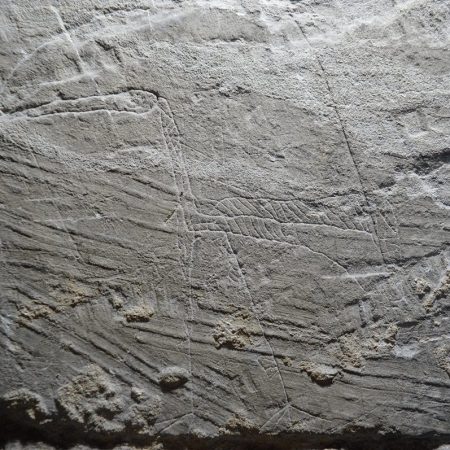The Hampshire Medieval Graffiti Project is organised by Historic Buildings section of the Hampshire Field Club and Archaeology Society.
It is one of a number of county surveys, all run by volunteers, locating and recording graffiti within historic buildings. These surveys follow the pioneering work carried out in East Anglia by the Norfolk Medieval Graffiti Survey, whose Director, Matthew Champion, launched the Hampshire group with a lecture and training session in 2016.
Although graffiti nowadays receive a bad press, in the past they seem to have been much more acceptable, and reflect the beliefs and mindsets of ordinary people whose voices are otherwise missing from the contemporary record. Many of the early graffiti found are symbols used to ward off the Devil and evil spirits (termed ‘apotropaic’). These are common finds in domestic and agricultural buildings, particularly around doorways and windows, where evil spirits might enter.
One of the most common of these symbols is the hexafoil or daisy wheel. Also found are pairs of interlocking Vs, which were originally devotional marks for the Virgin Mary, the VV standing for Virgo Virgorum. These are sometimes inverted to form an M, for Maria. After the Reformation the symbols seem to continue as protective marks. These marks are also common in churches, and demonstrate a ‘belt and braces’ approach to fending off the Devil, whose presence was a very real threat, even within God’s house.
Christian symbols can be inscribed into surfaces, most commonly crosses. These are often found around church entrances and in porches, and while they may represent tokens of personal devotion, some may also be connected with parish business, as business deals and agreements were often carried out in church porches. This may also account for the number of names, initials and dates which are also prevalent in porches and doorways. We believe that some names and dates, enclosed within elaborate frames, particularly of the 17th and 18th century, were meant to act as memorials, commemorating those who perhaps could not afford an expensive gravestone.
Other types of graffiti found include animals and birds, faces and figures, music, ships, heraldic devices and architectural designs. Although they are not graffiti, we also record scratch dials and masons’ marks.
Despite the name of the project, all graffiti found are recorded. This is because it is often difficult to date them precisely, and also because later graffiti, often in the forms of names and dates, may be useful for researching family history. A good source of such names is on pews and around the organ casing, where the young men tasked with pumping the organ, during periods of inactivity, obviously occupied themselves by leaving their names and sometimes irreverent comments.
Surveys have been carried out in more than 50 buildings in the county so far. Most of these are churches but other sites have been surveyed, including Southampton’s Bargate and its medieval vaults, and the Hospital of St Cross in Winchester.
Summaries of the project’s findings can be found in the relevant Historic Environment Record , in the HFC Newsletter, and on websites: www.hantsfieldclub.org.uk , www.southamptonarchaeology.uk
Anyone with an interest in helping with the project should contact the Karen Wardley, via the HFC website.
Contributed by Karen Wardley, Co-ordinator, Hampshire Medieval Graffiti ProjectDaisyEarly depiction of a Brother of St Cross Hospital, Winchester, though the date may have been added later.

